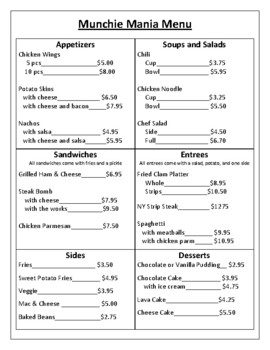Choice Board - Resaurant Addition (Decimals)
Supporting Educators
1 Follower
Grade Levels
Not Grade Specific
Subjects
Resource Type
Standards
CCSS2.NBT.B.5
CCSS2.NBT.B.6
CCSS6.NS.B.3
CCSSMP1
Formats Included
- PDF
Supporting Educators
1 Follower
Description
A Choice Board for students to practice their adding and subtracting skills with decimals, a real-world application. Using Choice Boards allows students to have some say in how they learn/practice their skills.
Total Pages
Answer Key
N/A
Teaching Duration
N/A
Last updated Dec 2nd, 2020
Report this resource to TPT
Reported resources will be reviewed by our team. Report this resource to let us know if this resource violates TPT’s content guidelines.
Standards
to see state-specific standards (only available in the US).
CCSS2.NBT.B.5
Fluently add and subtract within 100 using strategies based on place value, properties of operations, and/or the relationship between addition and subtraction.
CCSS2.NBT.B.6
Add up to four two-digit numbers using strategies based on place value and properties of operations.
CCSS6.NS.B.3
Fluently add, subtract, multiply, and divide multi-digit decimals using the standard algorithm for each operation.
CCSSMP1
Make sense of problems and persevere in solving them. Mathematically proficient students start by explaining to themselves the meaning of a problem and looking for entry points to its solution. They analyze givens, constraints, relationships, and goals. They make conjectures about the form and meaning of the solution and plan a solution pathway rather than simply jumping into a solution attempt. They consider analogous problems, and try special cases and simpler forms of the original problem in order to gain insight into its solution. They monitor and evaluate their progress and change course if necessary. Older students might, depending on the context of the problem, transform algebraic expressions or change the viewing window on their graphing calculator to get the information they need. Mathematically proficient students can explain correspondences between equations, verbal descriptions, tables, and graphs or draw diagrams of important features and relationships, graph data, and search for regularity or trends. Younger students might rely on using concrete objects or pictures to help conceptualize and solve a problem. Mathematically proficient students check their answers to problems using a different method, and they continually ask themselves, "Does this make sense?" They can understand the approaches of others to solving complex problems and identify correspondences between different approaches.





